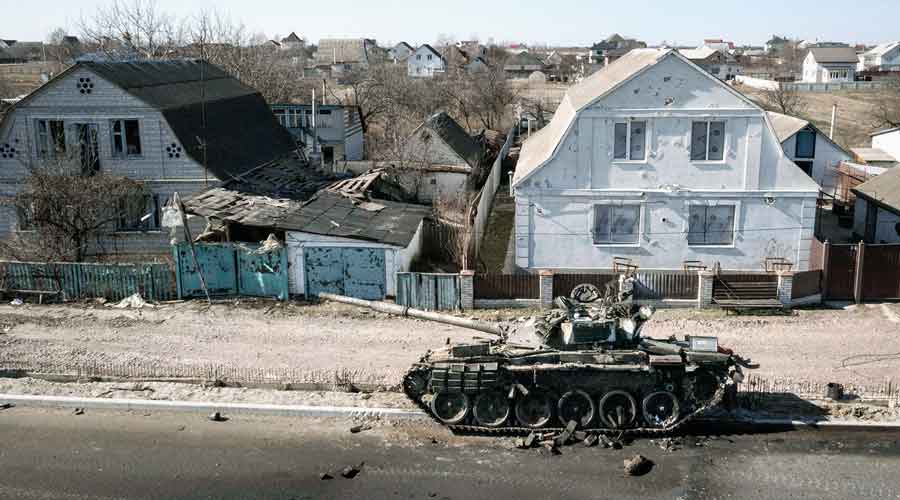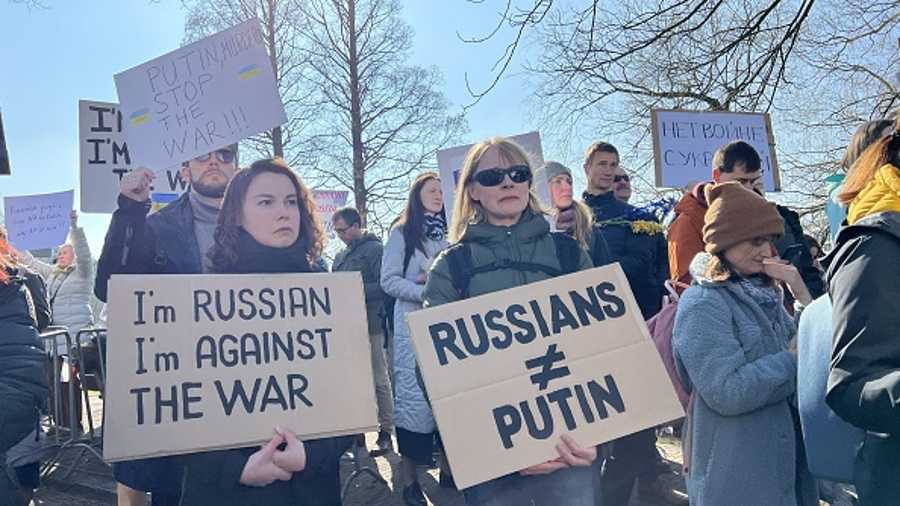The column of Russian tanks rumbled along a main highway to the east of Kyiv, between two rows of houses in a small town — a vulnerable target.
Soon, Ukrainian forces were sending artillery shells raining down on the Russian convoy, while soldiers ambushed them with anti-tank missiles, leaving a line of charred, burning tanks.
Brovary is just 12.8km from downtown Kyiv, and the skirmish on the M01 Highway on Wednesday illustrated how close Russian forces have come as they continue to tighten a noose on Ukraine’s capital — the biggest prize of all in the war.
Conflict raged close to Kyiv on Saturday, with combat to the northwest and east that consisted mostly of fierce, seesaw battles for control of small towns and roads. (See Page 2)
But the attack by Ukrainian troops in Brovary also cast into sharp relief the strategic challenges — and, military analysts say, the strategic missteps — that have bedevilled the Russian forces and prevented them, so far, from gaining control of most major cities.
Although the Russian forces greatly outnumber the Ukrainian army and have far superior weaponry, their size and their need to mostly use open roads make them less mobile and susceptible to attack from Ukrainian troops that can launch artillery strikes from several miles away, in tandem with surgical ambushes.
“Urban combat is always difficult, and I don’t think the Russians are any better at it than others,” said Tor Bukkvol, a senior research fellow at the Norwegian Defence Research Establishment, a military think tank and an authority on Russia’s special forces.
He said the Russian military was engaged in a plodding, armoured advance into the urban landscape of the city’s outlying towns.
“I’m not sure there is much of a strategy at the moment,” he said.
Illia Berezenko, a Ukrainian soldier who witnessed the Ukrainian attack on the Russian armoured column on Wednesday from a distant position but did not take part in it, said it aimed to hit the first and last tank in the column, in hopes of trapping those in the middle.
From that perspective, the strike, which set off fighting through a swath of villages in this area that is still ongoing, was only a partial success. In drone video of the ambush released by the Ukrainian army, which largely corresponds to Private Berezenko’s account, many Russian armoured vehicles can be seen driving away, apparently unharmed, while others burn.
Still, Private Berezenko said that from his viewpoint as a soldier, the episode was indicative of Russian mistakes. The cluster of armoured vehicles on the road was an easy target, he said. “Their artillery came first, then their tanks. The whole scenario was weird,” he said.
He said the column was moving with self-propelled artillery vehicles, which typically operate to the rear of frontline forces, mixed with tanks. Indeed, in the video released by the Ukrainian military, what appears to be a Russian Tos-1, a rocket artillery launcher nicknamed the Pinocchio for its bulging nose-like box of rockets, is seen driving amid the mayhem of exploding tanks.
“I don’t know why they are doing it,” Private Berezenko said. “Maybe they want to confuse us. Maybe they have some other understanding of what they are doing. Who knows?”
He said days of artillery shelling had dulled his nerves. “I was feeling normal” and not nervous during the skirmish, he said. “There is nothing exciting about seeing a tank. Everybody wants to live.”
Military analysts share Ukrainian soldiers’ puzzlement over the halting Russian advances toward Kyiv so far. It might be a pause while a new strategy is devised, said Dima Adamsky, an expert on Russian security policy at Reichman University in Israel.
On the first day of the war, the Russian military attempted a lightning raid on the capital using special forces in an elite airborne unit. These troops tried to seize an airfield north of Kyiv, in the town of Hostomel, in a helicopter assault with the apparent goal of creating a staging area for a quick attack.
But Ukrainian troops shot down a number of helicopters, sending the operation into disarray, then drove those Russians who had managed to land off the airfield and into a forest, according to Ukrainian soldiers who took part in that battle.
Russian armoured columns moving towards the capital from Belarus became bogged down in unexpectedly fierce resistance. Military analysts say these circumstances left the Russian army with no good choices as it advanced toward Kyiv.
“They were convinced in the success of Plan A, that they would take Kyiv without a lot of bloodshed, but now are reverting to an older form of warfare,” said Bukkvol of the Norwegian research centre.
For the Ukrainians, he said, the strategy will be to “draw the enemy into the city”, where armoured vehicles are channelled into streets, rather than spread out in fields.
This tactic was evident in the strike on the column outside of Brovary, where armoured vehicles were hit as they exited the open fields and entered a stretch of highway bordered by houses, blocking any escapes.
The Ukrainians, said Private Berezenko, fired with “pretty much everything they had” including anti-tank missiles from close range and artillery from farther away. He was ordered to a fallback position and didn’t see the aftermath.
Videos posted on Ukrainian social networks showed an armoured personnel carrier, peeled open by an explosion and spewing yellow flames. A Reuters videographer shot footage of Ukrainian soldiers starting up and driving away an abandoned Russian tank. It was unclear how many armoured vehicles were in the column and how many were destroyed.
The drone video of the attack also cheered Ukrainian soldiers inside the city. “It was beautiful,” said one soldier manning a checkpoint who declined to be identified. “We just poured it onto them.”
The video showed plumes of black smoke and dust bursting on the pavement and a tank apparently trying, awkwardly, to pivot on the shoulder of the road to head back the other way.
Driving out of Kyiv to the east, the high-rises of the city centre give way to malls, gas stations and furniture stores, then a forest and a few miles away the suburban community of Brovary.
While the strike forced the Russian column to retreat, days of fighting ensued in the villages east of here. And it was not without Ukrainian casualties.
In the hours and days after the strike, 20 wounded soldiers and civilians arrived at the hospital in Brovary. Volodymyr Andriets, the deputy director of the emergency room, said all had suffered concussions or wounds from shrapnel or bullets.
They included members of a family whose car was shot at on Thursday by Russian forces who had dispersed into a wooded area east of the town after Wednesday’s ambush.
The father, Sergei Lugina, said a bullet hit his 14-year-old daughter, Yekaterina, in the right shoulder and another blew off three fingers on his right hand. He said he managed to keep driving until he reached a Ukrainian checkpoint.
One soldier had a gaping shrapnel wound in his right wrist but was resisting recommendations to amputate, Andriets said.
“He understands he will lose his hand” but was still resisting, Andriets said.
The shock was wearing off and the soldier was becoming depressed, he said. Of the successful ambush on the M01 highway east of Brovary, Andriets said: “He’s not thinking of this now. Maybe later he will understand this was a victory for Ukraine.”
New York Times News Service











